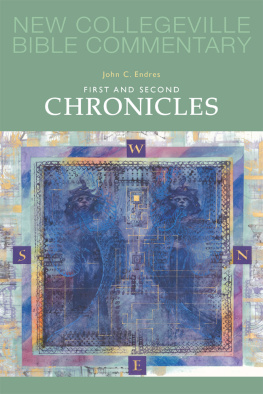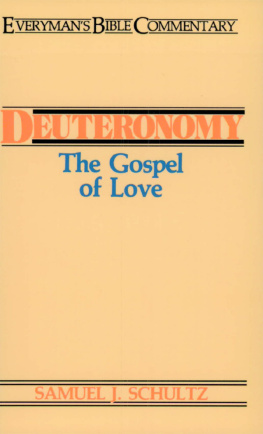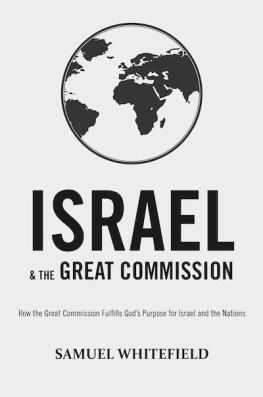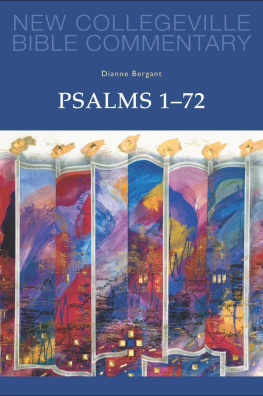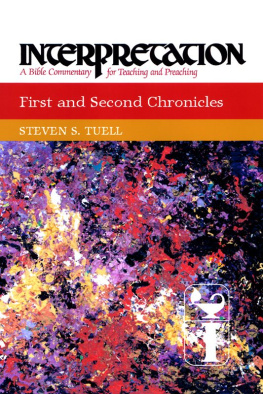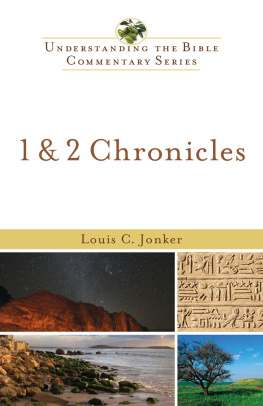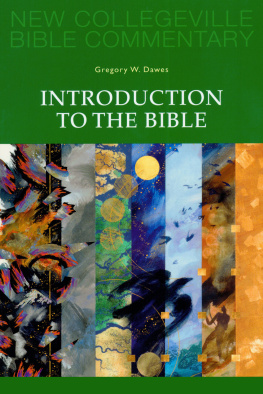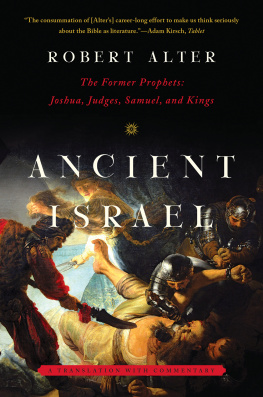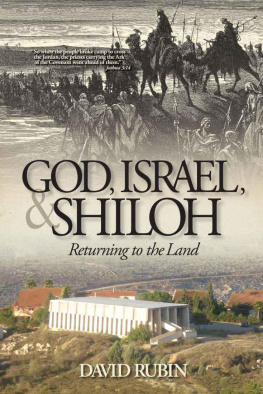All content available from the Liturgical Press website is protected by copyright and is owned or controlled by Liturgical Press.
You may print or download to a local hard disk the e-book content for your personal and non-commercial use only equal to the number of copies purchased. Each reproduction must include the title and full copyright notice as it appears in the content.
UNAUTHORIZED COPYING, REPRODUCTION, REPUBLISHING, UPLOADING, DOWNLOADING, DISTRIBUTION, POSTING, TRANSMITTING OR DUPLICATING ANY OF THE MATERIAL IS PROHIBITED.
E-ISBN: 978-0-8146-4780-6
Nihil Obstat: Reverend Robert C. Harren, J.C.L.
Imprimatur: Most Reverend John F. Kinney, J.C.D., D.D., Bishop of Saint Cloud, Minnesota, December 12, 2011.
Design by Ann Blattner.
Cover illustration: Solomons Temple by Donald Jackson. Copyright 2010 The Saint Johns Bible, Order of Saint Benedict, Collegeville, Minnesota USA. Used by permission. All rights reserved.
Maps created by Robert Cronan of Lucidity Design, LLC.
Scripture texts used in this work are taken from the New American Bible, revised edition 2010, 1991, 1986, 1970 Confraternity of Christian Doctrine, Inc., Washington, DC. All rights reserved. No part of this work may be reproduced or transmitted in any form or by any means, electronic or mechanical, including photocopying, recording, or by any information storage and retrieval system, without permission in writing from the copyright owner.
2012 by Order of Saint Benedict, Collegeville, Minnesota. All rights reserved. No part of this book may be reproduced in any form, by print, microfilm, microfiche, mechanical recording, photocopying, translation, or by any other means, known or yet unknown, for any purpose except brief quotations in reviews, without the previous written permission of Liturgical Press, Saint Johns Abbey, PO Box 7500, Collegeville, Minnesota 56321-7500. Printed in the United States of America.
Library of Congress Cataloging-in-Publication Data
Endres, John C., 1946
First and Second Chronicles / John C. Endres.
p. cm. (New Collegeville Bible commentary. Old Testament ; v. 10)
ISBN 978-0-8146-2844-7
1. Bible. O.T. ChroniclesCommentaries. I. Bible. O.T. Chronicles. English. New American. 2011. II. Title.
BS1345.53.E53 2011
222'.6077dc23
2011046899
CONTENTS
ABBREVIATIONS
Books of the Bible
ActsActs of the Apostles
AmosAmos
BarBaruch
1 Chr1 Chronicles
2 Chr2 Chronicles
ColColossians
1 Cor1 Corinthians
2 Cor2 Corinthians
DanDaniel
DeutDeuteronomy
Eccl (or Qoh)Ecclesiastes
EphEphesians
EsthEsther
ExodExodus
EzekEzekiel
EzraEzra
GalGalatians
GenGenesis
HabHabakkuk
HagHaggai
HebHebrews
HosHosea
IsaIsaiah
JasJames
JdtJudith
JerJeremiah
JobJob
JoelJoel
JohnJohn
1 John1 John
2 John2 John
3 John3 John
JonahJonah
JoshJoshua
JudeJude
JudgJudges
1 Kgs1 Kings
2 Kgs2 Kings
LamLamentations
LevLeviticus
LukeLuke
1 Macc1 Maccabees
2 Macc2 Maccabees
MalMalachi
MarkMark
MattMatthew
MicMicah
NahNahum
NehNehemiah
NumNumbers
ObadObadiah
1 Pet1 Peter
2 Pet2 Peter
PhilPhilippians
PhlmPhilemon
ProvProverbs
Ps(s)Psalms
RevRevelation
RomRomans
RuthRuth
1 Sam1 Samuel
2 Sam2 Samuel
SirSirach
SongSong of Songs
1 Thess1 Thessalonians
2 Thess2 Thessalonians
1 Tim1 Timothy
2 Tim2 Timothy
TitusTitus
TobTobit
WisWisdom
ZechZechariah
ZephZephaniah
INTRODUCTION
The Books of First and Second Chronicles
During the era of Persian rule (539332 B.C.), when the land of Israel was known as the province of Yehud, a Jewish writer with close connections to the Jerusalem temple authored a new version of Israels sacred story. Crafted for the Jewish people of his time, Chronicles spans the time from the creation of the world through the end of the Babylonian exile and Cyrus permission for Jews to return home in 538 B.C. These books tell the story from a special perspective. They emphasize the relationship with God centered at the temple and focus on Israels monarchs as leaders in political and religious matters, cooperating with Levites, priests, and prophets. For example, in Chronicles there is little concern for the split between the northern and southern kingdoms after Solomon. Jerusalem is Gods chosen city, the temple is Gods special place of presence, and public worship and song are critical aspects of Israels public life. God appears as mighty power, transcendent divinity, creator and sustainer of the world. There are no other gods as rivals.
These views come from the same storyline as that in the books of Deuteronomy through 2 Kings, often referred to as the Deuteronomistic History. The Chronicler, however, paints this picture with different shades and accents. Often, such differences can be easily traced when the Chronicler follows the story in the Deuteronomistic History rather closely. In fact, one can read 12 Chronicles synoptically, comparing it with Samuel and Kings, much as one reads Matthew, Mark, and Luke in synoptic fashion. In this commentary we will attend to the Chroniclers alterations of the older text as he rewrites Israels history. As we observe his changes to the story, some very obvious, many very subtle, we will notice how his theological perspective differs greatly from the earlier history. One difference is striking: the Deuteronomistic History views the era of the monarchy as a downward spiral leading to the Babylonian exile, and blames the regression on sinful actions of the kings. The Chronicler, on the other hand, presents a far more positive view of kings, especially those of Judah. He implies that their ways of conduct, especially their faith and their attention to God through worship, can lead to bountiful blessings for Israel. For the Chronicler, Israel is the Jewish people in Judah in the postexilic era, so the message to his audience is that they can enjoy more blessings if they wholeheartedly dedicate themselves to their God.
Israels early history is recounted in these books quite differently than in the Pentateuch. 1 Chronicles 19 consist of a series of genealogies, which cover time from the creation of the world up to the reign of Saul. While many connections exist between people in the genealogies and persons known from stories elsewhere, Chronicles does not entirely depend on narratives. Rather the story is carried through the genealogical connections. King Davids reign constitutes the second part of this book (1 Chr 1029). Here, the Chronicler repeats much of the material in the books of Samuel and describes Davids plans for the temple and its personnel in much greater detail (1 Chr 2229). Solomons reign (2 Chr 19) was a wonderful time for later Israel to remember and to emulate; it includes his building and dedication of the temple and lacks the negative evaluation of him found in 1 Kings 11:1022. 2 Chronicles 1036 narrates the history of the kingdom of Judah, with special focus on the exemplary rule of kings Jehoshaphat, Hezekiah, and Josiah. Chronicles generally omits criticism of kings in the northern kingdom of Israel, so the Chronicler may be seen to favor a reunion of the northern and southern kingdoms. In short, we can say that the Chronicler rewrites the Pentateuch by way of genealogies, and the books of Joshua through 2 Kings by a new version of the history emphasizing Davids line.

